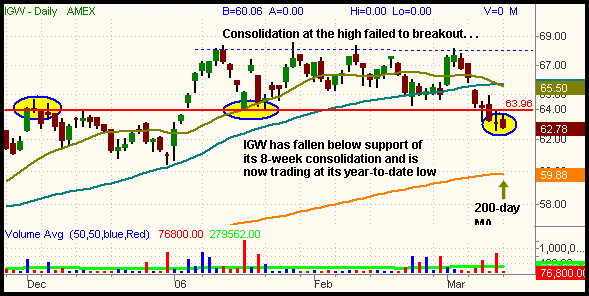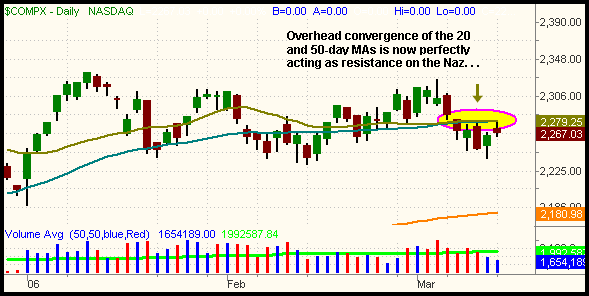After beginning the day with an opening gap higher, the broad market rallied for the first forty-five minutes of trading, but stocks subsequently ran out of gas and drifted lower throughout the remainder of the day. All the major indices except the Dow closed higher yesterday, although they gave back most of their intraday gains. The S&P 500, Nasdaq Composite, and small-cap Russell 2000 indices each advanced 0.2%, while the Dow Jones Industrial Average was unchanged. The S&P Midcap 400 Index gained 0.4%. The Nasdaq finished near its worst level of the session and the S&P 500 finished near the middle of its range. However, yesterday's intraday range in the S&P was only six points.
The fact that stocks were not able to maintain most of their morning gains showed a lack of conviction amongst institutional traders, as did the fact that volume levels decreased across the board. Total volume in the NYSE was 7% lighter than the previous day's level, while volume in the Nasdaq declined by 3%. Turnover in both exchanges was below 50-day average levels for the past two days, which is negative considering that the major indices attempted to rally during the same period. Mediocre market internals confirmed the lackluster session. In the Nasdaq, advancing volume barely exceeded declining volume, while the adv/dec volume ratio in the NYSE was positive by only 3 to 2. In the big picture, we have only seen three days of higher volume selling within the past four weeks ("distribution days"), but sessions of higher volume gains ("accumulation days") have been even more rare. Institutional volume patterns have erred to the bearish side in recent weeks, but the market's losses have been more the result of a lack of firm buying interest as opposed to heavy selling operations.
As we briefly touched on yesterday, one of the biggest problems facing the broad market right now is major relative weakness in the tech stocks and the Semiconductor Index ($SOX) in particular. Only a few weeks ago, the $SOX was consolidating near its 52-week high, showing relative strength and poised for a breakout to new highs. But Intel's negative report on March 3 had a widespread impact throughout the $SOX, which has closed lower for the past seven consecutive sessions! This bearish action in the $SOX is important because the Semis are so heavily weighted within the Nasdaq. Historically, weakness in the $SOX often precedes losses in the Nasdaq. Conversely, the Nasdaq rarely posts substantial gains without the semiconductor stocks leading the way.
Below is a daily chart of IGW (iShares Semiconductor). We illustrate IGW because its chart pattern currently mirrors the actual $SOX index much more closely than SMH (Semiconductor HOLDR). SMH has been severely lagging behind due to an over-weighting in Intel within the context of its portfolio of underlying stocks. Notice how IGW has fallen below support of its consolidation (the red horizontal line) and is trading at its year-to-date low:

We obviously expect the $SOX and IGW to at least have a small technical bounce within the next several days, but a lot of overhead supply and resistance has been created in the wake of the sector's recent relative weakness. Unless something drastically changes in this sector, we feel it will continue to weigh down the Nasdaq, and hence the entire broad market.
Weakness in the tech stocks has also prevented the Nasdaq from rallying back above new resistance of its 20 and 50-day moving averages over the past week. Both of those moving averages have converged and are now acting like a brick wall. Notice how the 20 and 50-MA convergence stopped yesterday morning's rally dead in its tracks and subsequently aided the afternoon weakness:

If you look at the weekly chart of the S&P 500, you will notice there has been little actual price movement for the past four weeks. Further, the intra-week range of the S&P's consolidation has also been very narrow. Needless to say, it is always more challenging for trend traders to find low-risk opportunities in a range-bound market. The good news, however, is that we don't expect the volatility contraction to continue much longer. With major relative weakness in the tech stocks, a complete lack of sector leadership, and lackluster performances from the former stock market leaders, we feel it is only a matter of time until we see a large volatility expansion in the S&P. We feel the direction of this expansion will be to the downside, but anything is possible when an index remains so close to its 52-week high. Therefore, remain vigilant and keep those stops in place. Be careful not to overtrade until the market resolves itself in one direction or the other. Overtrading in this environment can easily cause you to churn your account and bleed away your previous hard-earned profits.
Deron Wagner is the Founder and Head Trader of both Morpheus Capital LP, a U.S. hedge fund, and Morpheus Trading Group, a trader education firm launched in 2001 that provides daily technical analysis of the leading ETFs and stocks. For a free trial to the full version of The Wagner Daily or to learn about Wagner's other services, visit MorpheusTrading.com or send an e-mail to deron@morpheustrading.com.